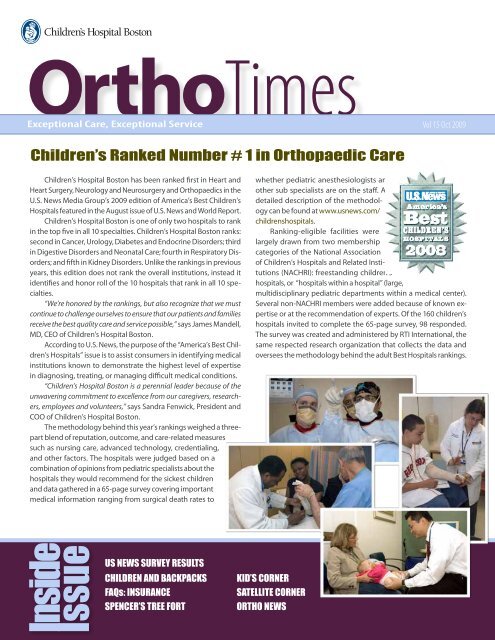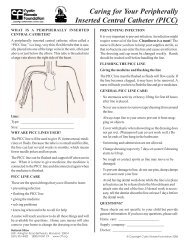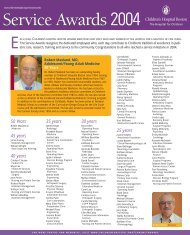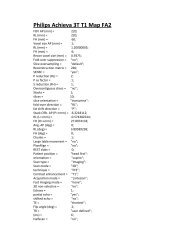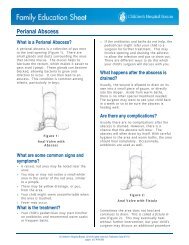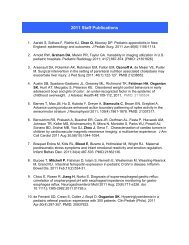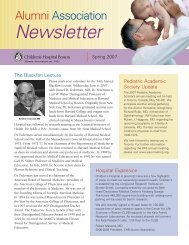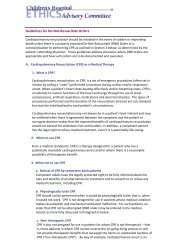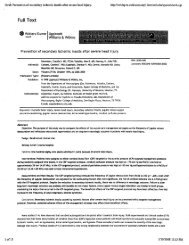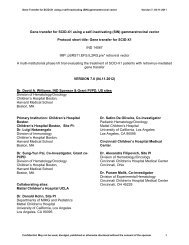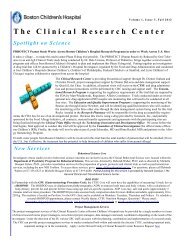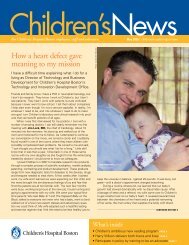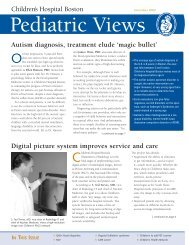FAQs: Insurance, Copays, And Referrals - Children's Hospital Boston
FAQs: Insurance, Copays, And Referrals - Children's Hospital Boston
FAQs: Insurance, Copays, And Referrals - Children's Hospital Boston
Create successful ePaper yourself
Turn your PDF publications into a flip-book with our unique Google optimized e-Paper software.
OrthoTimes Exceptional Care, Exceptional Service<br />
Vol<br />
Children’s Ranked Number # 1 in Orthopaedic Care<br />
Children’s <strong>Hospital</strong> <strong>Boston</strong> has been ranked first in Heart and<br />
Heart Surgery, Neurology and Neurosurgery and Orthopaedics in the<br />
U.S. News Media Group’s 2009 edition of America’s Best Children’s<br />
<strong>Hospital</strong>s featured in the August issue of U.S. News and World Report.<br />
Children’s <strong>Hospital</strong> <strong>Boston</strong> is one of only two hospitals to rank<br />
in the top five in all 10 specialties. Children’s <strong>Hospital</strong> <strong>Boston</strong> ranks:<br />
second in Cancer, Urology, Diabetes and Endocrine Disorders; third<br />
in Digestive Disorders and Neonatal Care; fourth in Respiratory Disorders;<br />
and fifth in Kidney Disorders. Unlike the rankings in previous<br />
years, this edition does not rank the overall institutions, instead it<br />
identifies and honor roll of the 10 hospitals that rank in all 10 specialties.<br />
“We’re honored by the rankings, but also recognize that we must<br />
continue to challenge ourselves to ensure that our patients and families<br />
receive the best quality care and service possible,” says James Mandell,<br />
MD, CEO of Children’s <strong>Hospital</strong> <strong>Boston</strong>.<br />
According to U.S. News, the purpose of the “America’s Best Children’s<br />
<strong>Hospital</strong>s” issue is to assist consumers in identifying medical<br />
institutions known to demonstrate the highest level of expertise<br />
in diagnosing, treating, or managing difficult medical conditions.<br />
“Children’s <strong>Hospital</strong> <strong>Boston</strong> is a perennial leader because of the<br />
unwavering commitment to excellence from our caregivers, researchers,<br />
employees and volunteers,” says Sandra Fenwick, President and<br />
COO of Children’s <strong>Hospital</strong> <strong>Boston</strong>.<br />
The methodology behind this year’s rankings weighed a threepart<br />
blend of reputation, outcome, and care-related measures<br />
such as nursing care, advanced technology, credentialing,<br />
and other factors. The hospitals were judged based on a<br />
combination of opinions from pediatric specialists about the<br />
hospitals they would recommend for the sickest children<br />
and data gathered in a 65-page survey covering important<br />
medical information ranging from surgical death rates to<br />
Inside<br />
Issue<br />
US NEWS SURVEY RESULTS<br />
CHILDREN AND BACKPACKS KID’S CORNER<br />
<strong>FAQs</strong>: INSURANCE SATELLITE CORNER<br />
SPENCER’S TREE FORT ORTHO NEWS<br />
15 Oct 2009<br />
whether pediatric anesthesiologists and<br />
other sub specialists are on the staff. A<br />
detailed description of the methodology<br />
can be found at www.usnews.com/<br />
childrenshospitals.<br />
Ranking-eligible facilities were<br />
largely drawn from two membership<br />
categories of the National Association<br />
of Children’s <strong>Hospital</strong>s and Related Institutions<br />
(NACHRI): freestanding children’s<br />
hospitals, or “hospitals within a hospital” (large,<br />
multidisciplinary pediatric departments within a medical center).<br />
Several non-NACHRI members were added because of known expertise<br />
or at the recommendation of experts. Of the 160 children’s<br />
hospitals invited to complete the 65-page survey, 98 responded.<br />
The survey was created and administered by RTI International, the<br />
same respected research organization that collects the data and<br />
oversees the methodology behind the adult Best <strong>Hospital</strong>s rankings.
Children & Backpacks | Daniel Hedequist, MD<br />
The presence of back pain or spinal deformity are the two<br />
most common reasons patients are referred to the spine program<br />
at Children’s. One of the most frequently asked questions relate<br />
to the use of backpacks at school and any cause and<br />
effect that they may have on spinal<br />
conditions. Large and<br />
heavy backpacks seem to<br />
be a more recent phenomena<br />
related to less<br />
school lockers, larger<br />
textbooks, and less<br />
time between classes<br />
given in order to<br />
unload books at<br />
the locker.<br />
The use of<br />
heavy backpacks<br />
will certainly cause<br />
children to droop at<br />
the shoulders, bend<br />
improperly at the<br />
waist, or list forward<br />
to one side. These<br />
postural changes,<br />
while not permanent,<br />
are clearly<br />
associated with an<br />
<strong>FAQs</strong>: <strong>Insurance</strong>, <strong>Copays</strong>, and <strong>Referrals</strong> | Matthew White<br />
I have an insurance card, does this guarantee coverage?<br />
No. It is the responsibility of the insured to make sure their coverage<br />
is up to date and active. Call your insurance company if you<br />
have questions about your coverage.<br />
Do I have a copayment?<br />
It depends. It is important to bring your insurance card with you to<br />
all appointments. The amount of the copayment listed for Specialist<br />
will be your amount for a visit with our Orthopaedic specialists. If<br />
no tier for specialist level is listed, the amount listed for an Office<br />
Visit will be used.<br />
When do I pay my copayment? Can I be billed for it?<br />
Children’s policy requires all copayments to be paid at the time<br />
of service. Orthopaedics accepts cash, personal check, Visa, and<br />
MasterCard as forms of payment.<br />
Why do I need a referral?<br />
If your insurance only covers in-network providers, such as with an<br />
HMO, often times seeing a specialist at Children’s requires a referral<br />
from your primary care physician to be covered by your insurance.<br />
- 2 -<br />
increase in back pain in children. In a recent study, up to 46% of<br />
children complained of back pain with the use of their school<br />
backpack. Risk factors included: heavier backpacks, improper fitting<br />
packs, prolonged carrying of backpacks, and poorly fitting<br />
backpacks.<br />
In order to prevent some of these backpack related postural<br />
changes and episodes of back pain there are some steps that families<br />
can take. First, when shopping for a backpack studies have shown that<br />
in the short term, children will opt for a more cosmetically appealing<br />
backpack. However, the same group of children when forced to try out<br />
different packs for a week will inevitably pick the most comfortable<br />
and efficient packs over the trendier packs. We recommend packs that<br />
have dual shoulder straps and a pad that fits against the back. If at all<br />
possible a waist strap should be present in order to stabilize the load.<br />
The backpack should also be optimally sized and fit for a child’s age.<br />
A maximum of fifteen percent of your body weight should<br />
go into your backpack. If your load exceeds this, some objects<br />
should be placed into your locker or carried in your arms. As a rule,<br />
if a child has to move forward or bend forward in order to carry<br />
the pack then it is probably overloaded. Proper lifting techniques<br />
are also important: face the pack, bend at the knees and check<br />
the weight of the pack, then apply one shoulder strap at a time.<br />
Improving the fit of a backpack, minimizing the weight, and<br />
using proper lifting and carrying techniques should help alleviate<br />
any discomfort associated with backpack wear. Any questions or<br />
issues related to back pain or your backpack should be mentioned<br />
at your visit with the doctor.<br />
How do I get a referral? Where do I send it?<br />
Call your primary care physician (PCP). They can fax it directly to<br />
the Department of Orthopaedics at 617-730-0456.<br />
I’m not sure if I have an HMO or PPO. How do I know?<br />
Look on the front of your insurance card. It may say HMO, PPO,<br />
Managed Care, or one of several other options. For questions<br />
regarding your coverage, call your insurance provider.<br />
I have Network Health and need a prior authorization for my<br />
visit. Who do I call?<br />
You may call Network Health or your primary care physician for<br />
authorization. Network Health requires authorization to visit Orthopaedics<br />
at Children’s prior to scheduling an appointment, so<br />
it is important to contact them before you call to schedule an<br />
appointment with us. This will save you a lot of time.<br />
My insurance coverage and/or policy has changed. How do I<br />
update this with Children’s?<br />
You may update your information at check-in, or, to expedite your<br />
visit, you may call ahead to the Patient Access Center at 617-355-7906.
Spencer’s Tree Fort | Daniel Piersa<br />
Spencer Merrill is an 11 year old boy<br />
who has been coming to the Department of<br />
Orthopaedic Surgery at Children’s <strong>Hospital</strong><br />
<strong>Boston</strong> for about 10 years. Spencer has Spinal<br />
Muscular Atrophy.<br />
According to www.fsma.org, Spinal Muscular<br />
Atrophy (SMA), is a motor neuron disease.<br />
The motor neurons affect the voluntary<br />
muscles that are used for activities such as<br />
crawling, walking, head and neck control,<br />
and swallowing. Intellectual activity is normal<br />
in people with SMA and it is often observed<br />
that they are unusually bright and sociable.<br />
Approximately, 1 in 6,000 babies born are<br />
affected.<br />
Spencer’s family recently applied to<br />
the Make-A-Wish foundation (www.wish.<br />
org), and the foundation awarded Spencer<br />
a wish. Make-A-Wish foundation helps children’s<br />
wishes come true. Most children wish for a trip to Disney<br />
or to meet their favorite Red Sox player, but Spencer wished for<br />
something different. In fact, Make-A-Wish foundation awarded<br />
Spencer’s wish as the most imaginative wish in the state of New<br />
Hampshire.<br />
What did Spencer wish for? Well, at first he wanted a Helper<br />
Monkey, but those are only available for adults. So Spencer wished<br />
for the next best thing, a tree fort. Spencer’s family saw a wheel<br />
chair accessible tree fort 3-4 years ago at the Crotchet Mountain<br />
Rehab Center in New Hampshire. Spencer wanted his own.<br />
The tree fort at Crotchet Mountain was built by a Vermont<br />
based company who also built Spencer’s tree fort. The tree fort<br />
at Spencer’s house stands 6 feet off the ground, it measures 12x14<br />
Satellite Corner | Brad Herrick<br />
Orthopaedic Surgery has been a consummate department at<br />
the main campus of Children’s <strong>Hospital</strong> <strong>Boston</strong> since the hospital’s<br />
inception 140 years ago. Within the past two decades, the Department<br />
of Orthopaedic Surgery extended its services and opened its<br />
doors in several communities in eastern Massachusetts, in order to<br />
provide the same great Children’s care and attention that patients<br />
and families expect.<br />
At Children’s <strong>Hospital</strong> <strong>Boston</strong> at Waltham, for example,<br />
many of the orthopaedic providers hold the same outpatient clinics<br />
that they do in <strong>Boston</strong>. Physicians specializing in upper extremity,<br />
lower extremity, hip, spine, and other orthopaedic problems<br />
all see patients here. The Waltham satellite also offers imaging<br />
(X-ray, MRI, CT, nuclear medicine), lab, and physical/occupational<br />
therapy services to supplement the care provided by the physicians.<br />
Waltham has 6 operating rooms with 11 overnight surgical beds.<br />
- 3 -<br />
feet with a 3x14 foot deck. It is wheel chair accessible and is built<br />
into a real oak tree. The tree fort is wired with electricity, cable,<br />
and internet. It has a flat screen TV, a poker table, and a ceiling fan.<br />
I asked Spencer what his favorite part of the tree fort was and<br />
he said, “The mini fridge.” Inside the mini fridge, Spencer keeps<br />
juices and sodas. He also likes to play poker and Xbox on the flat<br />
screen with his friends. His favorite game is Call of Duty (he has<br />
every one). I asked Spencer if he still wished for the monkey and<br />
he said, “No way!”<br />
Spencer and his family would like to thank Make-A-Wish and<br />
the Department of Orthopaedic Surgery. Spencer wanted to let<br />
everyone know that he plans on spending as much time this summer<br />
in the tree fort with his friends.<br />
Thanks Spencer, you inspire us all here at Children’s.<br />
Children’s <strong>Hospital</strong> <strong>Boston</strong> at Lexington also has several of<br />
the same orthopaedic physicians whom you’d see in <strong>Boston</strong>. The<br />
Lexington satellite has a radiology department (X-ray) as well as<br />
physical/occupational therapy services. The Lexington facility is<br />
on Bedford Street, conveniently located right off of I-95.<br />
The Department of Orthopaedic Surgery extends its boundaries<br />
to the north and south shores of <strong>Boston</strong> at the Lahey Clinic in<br />
Peabody and the South Shore <strong>Hospital</strong> in Weymouth, respectively.<br />
While these orthopaedic clinics may be smaller than those<br />
at Children’s main campus in <strong>Boston</strong>, you can be sure that the<br />
same care is offered in an office that might be a more convenient<br />
outpatient alternative.<br />
Consider making your next appointment with us at one of<br />
our satellite locations, the Department of Orthopaedic Surgery<br />
might just be closer than you think. View maps and directions at<br />
www.childrenshospital.org/ortho.<br />
Spencer Merrill (image courtesy of the Merrill family)
KID’S CORNER<br />
t i b i a r a c b k l j<br />
Word Bank<br />
bones mandible<br />
femur muscle<br />
fibula patella<br />
humerus ribs<br />
leg scapula<br />
skull spine<br />
tibia ulna<br />
vertebrae<br />
Ortho News<br />
617-355-6021<br />
Opt. 2: Speak with a nurse<br />
Opt. 3: Schedule/ cancel/ confirm appts.<br />
Opt. 4: Speak with a surgical scheduler<br />
At the 2009 Annual Meeting of the<br />
American Orthopaedic Society for Sports<br />
Medicine (AOSSM), Mininder S. Kocher,<br />
MD, MPH, director of the Division of Sports<br />
Medicine, was elected to the Board of Directors<br />
of the AOSSM. The AOSSM is the<br />
preeminent orthopaedic sports medicine<br />
organization in the world for sports medicine<br />
education, research, communication,<br />
and fellowship.<br />
In June, John Emans, MD, director of<br />
the Division of Spinal Surgery, was recognized<br />
by the National Scoliosis Foundation<br />
for the help and hope he has given to so<br />
many children and families in the scoliosis<br />
community.<br />
Michael Millis, MD, director of the<br />
Adolescent and Young Adult Hip Program,<br />
won the Dr. Marian Ropes Award from the<br />
o s o x t s b i r h d h<br />
p m n b n e f i b u l a<br />
a q e e r t y u i m o p<br />
t s s c a p u l a e a e<br />
e d f k g h j e k r l a<br />
l n m b u v c g x u z r<br />
l w r l m l t y h s s b<br />
a e n n s i l n u h m e<br />
f a m u p k o d m k a t<br />
m a n d i b l e i d a r<br />
s c a p n t m u s c l e<br />
w r u m e f o n o e r v<br />
Children’s Orthopaedic<br />
Surgery Foundation<br />
300 Longwood Avenue/ Fegan 2<br />
<strong>Boston</strong> , MA 02115<br />
Arthritis Foundation. The award is for excellence<br />
in arthritis care and leadership in<br />
the fight against arthritis.<br />
At the 2009 Annual Meeting of the<br />
Pediatric Orthopaedic Society of North<br />
America (POSNA), Peter M. Waters, MD,<br />
Chief of Clinical Orthopaedics, was elected<br />
Vice-President of POSNA. Following a oneyear<br />
term, Dr. Waters will move into the<br />
post of President-elect and subsequently<br />
President of POSNA.<br />
Two new videos were recently added<br />
to our website: A Day in the Life of Orthopaedic<br />
Surgery, featuring orthopaedic staff,<br />
and Brachial Plexus Birth Palsy, featuring Dr.<br />
Peter Waters. We will be expanding our<br />
multimedia collection with future topics<br />
that include hip dysplasia, featuring Dr.<br />
Michael Millis, clubfoot, osteogenesis im-<br />
- 4 -<br />
childrenshospital.org/ortho<br />
perfecta, and leg length discrepancy. You<br />
can view these videos and more at www.<br />
childrenshospital.org/ortho.<br />
Children’s recently launched a new pediatric<br />
health and science blog, called Thrive<br />
(www.childrenshospitalblog.org). It will feature<br />
Children’s experts addressing timely<br />
health topics; videos of our patients, families,<br />
clinicians and researchers; and the latest<br />
health information from around the world.<br />
In addition, you can also now:<br />
Friend us on Facebook.<br />
www.facebook.com/childrenshospitaboston<br />
Follow us on Twitter.<br />
www.twitter.com/childrensboston<br />
Watch our videos on YouTube.<br />
www.youtube.com/childrenshospital


